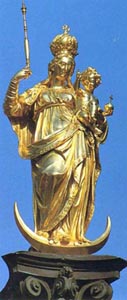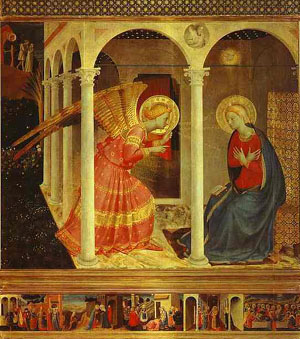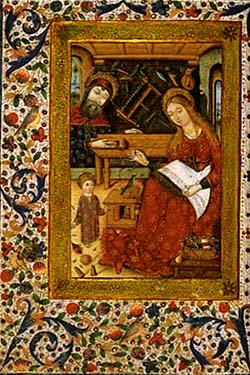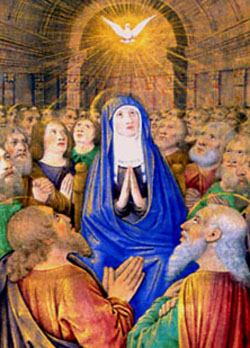 |
Feast Days of Our Lady
Our Lady Mediatrix of All Graces
November 8
Prof. Plinio Corrêa de Oliveira
Selection:
This devotion honors Our Lady as a cooperating agent in the plan of God from the Incarnation of Jesus Christ to the Redemption. Mary was the intermediary between Jesus and St. John the Baptist, sanctifying him before his birth. She was the one who asked Christ to make His first miracle at the wedding of Canaan before his public life had begun.

Our Lady is Mediatrix
|
During the Passion, she followed Him in every step of his sufferings, showing us that she was associated in the mission of reparation for the sins of mankind. After the Resurrection, the Holy Ghost descended upon her first, and then upon the Apostles, showing that she was the mediatrix of the graces for the nascent Church. By her divine maternity Mary became Co-Redemptix, taking on the role of Mediatrix of all graces.
In 1921 Pope Benedict XV instituted November 8 as the feast day of Our Lady Mediatrix of All Graces.
A text by St. Louis Grignion de Montfort expresses this truth admirably:
"Only Mary found grace before God (Luke 1:30) without the help of any other creature. And after her, all those who found grace before God found it only through her. Mary was full of grace when the Archangel Gabriel saluted her (Luke 1:28) and was filled with grace when the Holy Ghost so mysteriously overshadowed her (Luke 1:35).
"From day to day, from moment to moment, she increased so much this twofold plenitude that she attained an immense and inconceivable degree of grace. So much so, that the Almighty made of her the sole custodian of His treasures and sole dispenser of all His graces, so that she might ennoble, exalt and enrich all she chooses. She can lead them along the narrow path to Heaven and guide them through the narrow gate to life. She can give a royal throne, scepter and crown to whomever she wishes. Jesus is always and everywhere the Fruit and Son of Mary, and Mary is everywhere the true tree that bears the Fruit of life, the true Mother who bears that Son.”" (True Devotion to Mary, n. 44)
Comments of Prof. Plinio:
This is one of the most admirable texts of St. Louis Grignion de Montfort that almost dispenses with the need for commentary. But since our remarks are just a way to pay homage to Our Lady, let me go ahead.

The Annunciation by Fra Angelico
|
Behind the thinking of this excerpt is the truth that Our Lady is the Mediatrix of All Graces. This thought is linked to an admirable fact in the lives both of Our Lady and the Child Jesus: it is how grace continually increased in her. St. Louis Grignion explains this process.
Before the Annunciation, she was already full of grace, and had always been. But at a certain moment, by her most perfect correspondence to every grace at every moment, and also by a special predilection of God Our Lord toward her, the grace increased in such a way in her soul that she became worthy to be the Mother of Jesus Christ hypostatically united to the Second Person of the Holy Trinity. The Holy Ghost found her perfect to be His spouse, and the Word of God was conceived in her human flesh.
St. Louis offers the profound insight that at the moment of the Incarnation, Our Lady received a new plenitude of graces that was added to the first. She was already worthy to be both the Spouse of the Holy Ghost and the Mother of the Incarnated Word. Then, a new overflowing of graces occurred in her and she acquired a super-plenitude of grace.
One can imagine the immensity of graces she received during the gestation of Our Lord Jesus Christ as she formed Him, carrying Him in her womb for nine months. He lived in her as in a Tabernacle. One may only envisage the boons Our Lady received in her spiritual life coming from this contact of souls.
It was a kind of mutual gift: while she was forming His body, He was forming her soul and making her still more perfect, bestowing unheard-of graces. I don’t know if even the highest Angels are able to understand those graces. Now then, she corresponded perfectly to all those graces with an astonishing fidelity.

One can imagine the joys of the Holy Family in the House of Nazareth
|
After His birth, Our Lady continued to grow in her fidelity to grace during the 30 years of Our Lord’s private life, during which He desired that she command Him and He obey her. In the house of Nazareth, the human hierarchy was the opposite of the supernatural hierarchy. Of the three, the least was the enormously great St. Joseph, who was the head of the family; then, there was Our Lady, who, humanly speaking was subordinate to him even though she was greater than he in grace; finally, in the last place of the human hierarchy was the Son, who nevertheless was God. The Gospel tells us that Our Lord obeyed them.
We can imagine how Our Lady and St. Joseph acted toward Him knowing that He was God: “Now, my Son, I ask that you be so good as to help me sand this piece of wood,” or “Could you please help me set these plates of food so that we might eat?”
We can only have a pale idea of the respect and adoration with which they would command their Divine Son. For those 30 years it is impossible to imagine a more delightful relationship than that of those three persons in Nazareth. She increased in grace every day during those 30 years.
Our Lady then participated in the three years of Our Lord’s public life. During these years her close participation in the daily life of Our Lord diminished. She had to suffer the pain of the separation. To this also she was perfectly faithful. When she was with Him, she could see all the benefits He was giving to people, but also she saw all the ingratitude and unfaithfulness with which they were received.
She saw the glory of Our Lord, but also its futility for men who disregarded it. She saw the defeat that had already begun, the persecutions, the attempts of murder and, finally, the entire Passion and most sorrowful Death of Our Lord. Who can imagine the spiritual advantages for her soul that came from all those graces?

At the Pentecost the Holy Ghost descended on Our Lady and the Apostles |
The sanctification of Our Lady from the moment of the Ascension to the moment when the Holy Ghost descended upon her and the Apostles in the Cenacle only grew. She remained on earth in order to help establish the Church. Then, the moment arrived when God Himself could not make her more perfect. It was the moment of her Dormition and her successive Assumption to Heaven.
Considering the ensemble of graces she received and corresponded to perfectly, St. Louis Grignion, with his eagle’s gaze, says that she received more grace than any other person ever did or ever will. She received more graces than the ensemble of mankind and, therefore, the graces others receive are but a participation of the graces she received and an overflowing of them.
We understand, therefore, what the Universal Mediation of graces is. It is the graces that fall entirely to the sole Mediatrix between Jesus Christ and men, and from her they overflow to men.
If this is so, and we know it is, then, why should we be so concerned about our enemies, the Devil, the sadness that comes over us upon considering the fruits of Vatican II? When we know that Our Lady is full of grace and the Mediatrix of All Graces, even our sins become less distressing, because with just one word from her we can be freed of everything bad. We can become clean and pure again.
If we would be convinced of the immeasurable quantity and quality of graces that Our Lady has, we would have more confidence, more joy, and more hope in our spiritual lives. Such persuasion should come from the super-plenitude of graces that Our Lady has. She is the necessary door that leads us to Jesus Christ.
Let us close by praying a Memorare asking her to deign to establish in our souls the profound conviction that she is the Universal Mediatrix of All Graces.


Watch a video illustration of this Saint of the Day article
here

  | | Prof. Plinio Corrêa de Oliveira | |
The Saint of the Day features highlights from the lives of saints based on comments made by the late Prof. Plinio Corrêa de Oliveira. Following the example of St. John Bosco who used to make similar talks for the boys of his College, each evening it was Prof. Plinio’s custom to make a short commentary on the lives of the next day’s saint in a meeting for youth in order to encourage them in the practice of virtue and love for the Catholic Church. TIA thought that its readers could profit from these valuable commentaries.
The texts of both the biographical data and the comments come from personal notes taken by Atila S. Guimarães from 1964 to 1995. Given the fact that the source is a personal notebook, it is possible that at times the biographic notes transcribed here will not rigorously follow the original text read by Prof. Plinio. The commentaries have also been adapted and translated for TIA’s site.
|
Saint of the Day | Home | Books | CDs | Search | Contact Us | Donate

© 2002- Tradition in Action, Inc. All Rights Reserved
|
 |

|